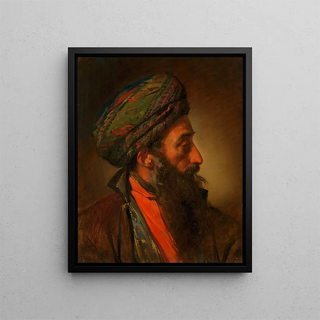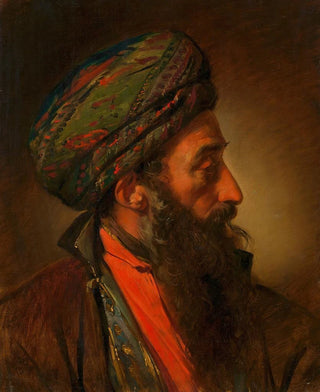Art print | A Turkish study chief - Friedrich von Amerling


View from behind

Frame (optional)
In the vast panorama of art history, certain works stand out for their ability to capture the essence of an era while transcending cultural boundaries. "Un chef d'étude turc" by Friedrich von Amerling is one of these remarkable creations. This piece, imbued with unparalleled delicacy and depth, offers a fascinating glimpse into the Oriental influences that marked Europe in the 19th century. Through this painting, the artist invites us to immerse ourselves in a universe where beauty and exoticism intertwine, transporting us to distant and mysterious lands.
Style and uniqueness of the work
Von Amerling's work is distinguished by meticulous attention to detail and a subtly nuanced color palette. "Un chef d'étude turc" highlights the richness of textiles and the complexity of the patterns adorning the subject's traditional costume. The interplay of light and shadow, skillfully controlled, adds an almost lifelike dimension to the depiction, making the character palpable and accessible. The artist manages to capture not only the physical appearance of his model but also an atmosphere charged with emotion and storytelling. This painting is not merely a portrait; it tells a story—of a man, of a culture, and of a specific moment in time. This ability to evoke deep feelings and arouse curiosity is what gives the work its singularity.
The artist and his influence
Friedrich von Amerling, born in 1803, was an Austrian painter whose work was heavily influenced by the Romantic movement. His training in Vienna and his travels in Italy and the Orient shaped his style, making it both classical and innovative. Von Amerling successfully integrated elements from different cultures into his works, creating a dialogue between the East and the West. His talent for portraiture, combined with a keen sensitivity to the psychological nuances of his subjects, earned him international recognition. Through "Un chef d'étude turc," he does not merely reproduce an image; he offers a reflection on identity and otherness, while celebrating

Matte finish

View from behind

Frame (optional)
In the vast panorama of art history, certain works stand out for their ability to capture the essence of an era while transcending cultural boundaries. "Un chef d'étude turc" by Friedrich von Amerling is one of these remarkable creations. This piece, imbued with unparalleled delicacy and depth, offers a fascinating glimpse into the Oriental influences that marked Europe in the 19th century. Through this painting, the artist invites us to immerse ourselves in a universe where beauty and exoticism intertwine, transporting us to distant and mysterious lands.
Style and uniqueness of the work
Von Amerling's work is distinguished by meticulous attention to detail and a subtly nuanced color palette. "Un chef d'étude turc" highlights the richness of textiles and the complexity of the patterns adorning the subject's traditional costume. The interplay of light and shadow, skillfully controlled, adds an almost lifelike dimension to the depiction, making the character palpable and accessible. The artist manages to capture not only the physical appearance of his model but also an atmosphere charged with emotion and storytelling. This painting is not merely a portrait; it tells a story—of a man, of a culture, and of a specific moment in time. This ability to evoke deep feelings and arouse curiosity is what gives the work its singularity.
The artist and his influence
Friedrich von Amerling, born in 1803, was an Austrian painter whose work was heavily influenced by the Romantic movement. His training in Vienna and his travels in Italy and the Orient shaped his style, making it both classical and innovative. Von Amerling successfully integrated elements from different cultures into his works, creating a dialogue between the East and the West. His talent for portraiture, combined with a keen sensitivity to the psychological nuances of his subjects, earned him international recognition. Through "Un chef d'étude turc," he does not merely reproduce an image; he offers a reflection on identity and otherness, while celebrating






